How Does a Hydraulic Brake Work?
Brakes are an essential component of any vehicle, as they are responsible for slowing down and stopping the vehicle. The brake system comprises various components that work in unison to provide the necessary stopping power. One of the most common types of brakes used in vehicles is the hydraulic brake. But how does a hydraulic brake work? In this article, we will explore the functioning of a hydraulic brake in detail.
What is a hydraulic brake?
A hydraulic brake is a type of brake system that uses brake fluid to transfer force from the brake pedal to the braking mechanism. The brake system comprises various components, including the brake pedal, master cylinder, brake lines, brake calipers, brake pads, and brake rotors. The hydraulic brake system can either be a disc brake or a drum brake.
Hydraulic brake components
1. Brake pedal
The brake pedal is the foot-operated lever that initiates the braking process. When the driver presses down on the brake pedal, it exerts force on the master cylinder, which generates hydraulic pressure.
2. Master cylinder
The master cylinder is the heart of the hydraulic brake system. It converts the mechanical force exerted by the brake pedal into hydraulic pressure. The master cylinder comprises a piston and two chambers filled with brake fluid. When the brake pedal is depressed, the piston moves forward, compressing the brake fluid in one chamber and forcing it into the brake lines.
3. Brake lines
The brake lines are the pipes that transport the brake fluid from the master cylinder to the brake calipers. The brake lines are made of metal or reinforced rubber to withstand the high pressure of the brake fluid.
4. Brake calipers
The brake calipers are the devices that hold the brake pads and apply pressure to the brake rotor to slow down or stop the vehicle. The brake calipers are located at each wheel and are connected to the brake lines. When the hydraulic pressure is applied, the brake calipers squeeze the brake pads against the brake rotor, creating friction and heat.
5. Brake pads
The brake pads are the replaceable components that press against the brake rotor to slow down or stop the vehicle. The brake pads are made of friction material, such as ceramic or metallic compounds, that can withstand high temperatures and provide excellent stopping power.
6. Brake rotor
The brake rotor is the circular metal disc that rotates with the wheel. The brake pads clamp onto the brake rotor, creating friction and heat that slows down or stops the vehicle.
Disc brakes vs. drum brakes
Hydraulic brakes can either be a disc brake or a drum brake. Disc brakes are the most common type of brakes used in modern vehicles. They consist of a brake rotor, brake pads, and a brake caliper. When the brake pedal is depressed, the brake caliper squeezes the brake pads against the brake rotor, creating friction and heat. Drum brakes, on the other hand, consist of a brake drum, brake shoes, and a brake wheel cylinder. When the brake pedal is depressed, the brake shoes press against the inside of the brake drum, creating friction and heat.
How does a hydraulic brake work?
When the driver presses down on the brake pedal, it exerts force on the master cylinder, which generates hydraulic pressure. The hydraulic pressure is then transmitted through the brake lines to the brake calipers. The brake calipers squeeze the brake pads against the brake rotor, creating friction and heat that slows down or stops the vehicle. The brake pads and brake rotor work together to convert the kinetic energy of the vehicle into heat energy, which is dissipated into the air.
The brake fluid plays a crucial role in the functioning of the hydraulic brake system. It transmits the hydraulic pressure from the master cylinder to the brake calipers and ensures that the braking mechanism operates smoothly and efficiently. The brake fluid also absorbs heat generated during the braking process, preventing the brake system from overheating.
Conclusion
In conclusion, the hydraulic brake system is an integral part of any vehicle’s safety mechanism. The brake system comprises various components that work together to provide the necessary stopping power. Understanding how the hydraulic brake system works can help drivers appreciate the importance of regular maintenance and servicing. It is essential to ensure that the brake components, such as the brake pads and brake fluid, are in good condition to ensure optimal braking performance and safety.







